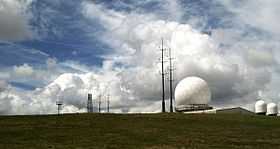Great Dun Fell
| Great Dun Fell | |
|---|---|
 The radar station on the summit | |
| Elevation | 848 m (2,782 ft) |
| Prominence | 76 m (249 ft) |
| Parent peak | Cross Fell |
| Listing | Hewitt, Nuttall |
| Location | |
| Location | Cumbria, England |
| Range | Pennines |
| OS grid | NY710321 |
| Topo map | OS Landranger 91 |
At a height of 2,782 feet, Great Dun Fell is the second-highest hill in England's Pennines, lying two miles south along the watershed from Cross Fell, its higher neighbour. Together with its smaller twin, Little Dun Fell, it forms a stepping-stone for the Pennine Way on its long climb up from Dufton.
Radar station
At the summit, there is a radar station that is operated by NATS and is a key part of the Air Traffic Control system for Northern England and Southern Scotland. A radome containing Primary Surveillance radar (PSR) and Secondary Surveillance Radar (SSR) antennae, various towers and fencing crown the summit. Alfred Wainwright abhorred the old radio station (removed in the 1980s) in his book Pennine Way Companion.
The construction of the radar station led to the repaving of a tarred road to the summit, which became Britain's highest road. This road is marked as private from just above the village of Knock, and not open to public motor vehicles. However, it is a bridleway until shortly before the radar station, so it is open to walkers, cyclists and horseriders.[1]
Great Dun Fell Field Station
The University of Manchester formerly had a permanent meteorological observatory at the Great Dunn Fell site. It has hosted a number of field experiments doing research into clouds and their interactions with pollution. As the summit is in cloud for two thirds of the year it is an ideal location for this type of research. The university still has the option to use the site for short term measurement periods.[2]
Hushing
There are the remains of hushing gulleys on the slopes of the mountain, created during lead mining of the industrial revolution.
References
- ↑ Ainsley, Rob (2008). 50 Quirky Bike Rides. Eye Books. p. 187.
- ↑ "Great Dun Fell Field Station". University of Manchester Centre for Atmospheric Science. Retrieved 19 July 2014.
External links
Coordinates: 54°40′59″N 2°27′05″W / 54.68311°N 2.45132°W
| ||||||||||||||